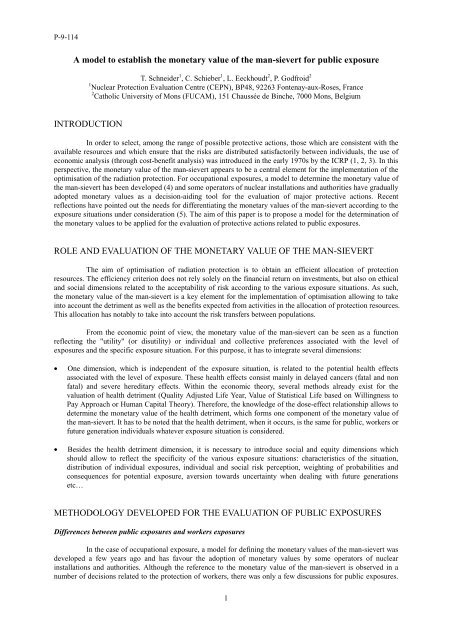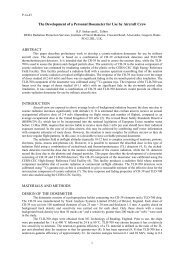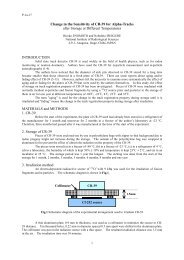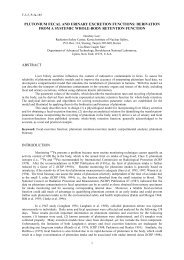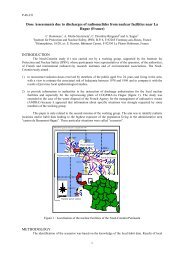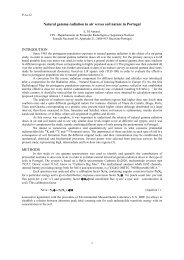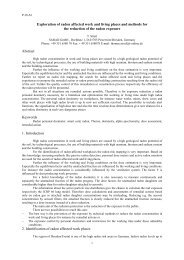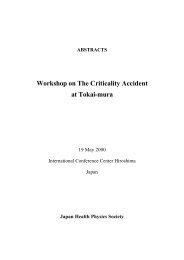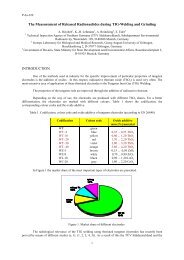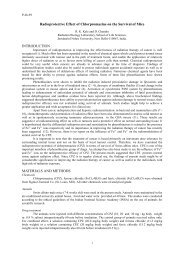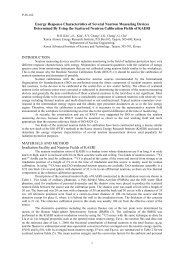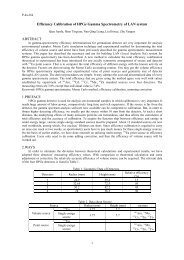A model to establish the monetary value of the man-sievert for public ...
A model to establish the monetary value of the man-sievert for public ...
A model to establish the monetary value of the man-sievert for public ...
You also want an ePaper? Increase the reach of your titles
YUMPU automatically turns print PDFs into web optimized ePapers that Google loves.
P-9-114<br />
A <strong>model</strong> <strong>to</strong> <strong>establish</strong> <strong>the</strong> <strong>monetary</strong> <strong>value</strong> <strong>of</strong> <strong>the</strong> <strong>man</strong>-<strong>sievert</strong> <strong>for</strong> <strong>public</strong> exposure<br />
T. Schneider 1 , C. Schieber 1 , L. Eeckhoudt 2 , P. Godfroid 2<br />
1 Nuclear Protection Evaluation Centre (CEPN), BP48, 92263 Fontenay-aux-Roses, France<br />
2 Catholic University <strong>of</strong> Mons (FUCAM), 151 Chaussée de Binche, 7000 Mons, Belgium<br />
INTRODUCTION<br />
In order <strong>to</strong> select, among <strong>the</strong> range <strong>of</strong> possible protective actions, those which are consistent with <strong>the</strong><br />
available resources and which ensure that <strong>the</strong> risks are distributed satisfac<strong>to</strong>rily between individuals, <strong>the</strong> use <strong>of</strong><br />
economic analysis (through cost-benefit analysis) was introduced in <strong>the</strong> early 1970s by <strong>the</strong> ICRP (1, 2, 3). In this<br />
perspective, <strong>the</strong> <strong>monetary</strong> <strong>value</strong> <strong>of</strong> <strong>the</strong> <strong>man</strong>-<strong>sievert</strong> appears <strong>to</strong> be a central element <strong>for</strong> <strong>the</strong> implementation <strong>of</strong> <strong>the</strong><br />
optimisation <strong>of</strong> <strong>the</strong> radiation protection. For occupational exposures, a <strong>model</strong> <strong>to</strong> determine <strong>the</strong> <strong>monetary</strong> <strong>value</strong> <strong>of</strong><br />
<strong>the</strong> <strong>man</strong>-<strong>sievert</strong> has been developed (4) and some opera<strong>to</strong>rs <strong>of</strong> nuclear installations and authorities have gradually<br />
adopted <strong>monetary</strong> <strong>value</strong>s as a decision-aiding <strong>to</strong>ol <strong>for</strong> <strong>the</strong> evaluation <strong>of</strong> major protective actions. Recent<br />
reflections have pointed out <strong>the</strong> needs <strong>for</strong> differentiating <strong>the</strong> <strong>monetary</strong> <strong>value</strong>s <strong>of</strong> <strong>the</strong> <strong>man</strong>-<strong>sievert</strong> according <strong>to</strong> <strong>the</strong><br />
exposure situations under consideration (5). The aim <strong>of</strong> this paper is <strong>to</strong> propose a <strong>model</strong> <strong>for</strong> <strong>the</strong> determination <strong>of</strong><br />
<strong>the</strong> <strong>monetary</strong> <strong>value</strong>s <strong>to</strong> be applied <strong>for</strong> <strong>the</strong> evaluation <strong>of</strong> protective actions related <strong>to</strong> <strong>public</strong> exposures.<br />
ROLE AND EVALUATION OF THE MONETARY VALUE OF THE MAN-SIEVERT<br />
The aim <strong>of</strong> optimisation <strong>of</strong> radiation protection is <strong>to</strong> obtain an efficient allocation <strong>of</strong> protection<br />
resources. The efficiency criterion does not rely solely on <strong>the</strong> financial return on investments, but also on ethical<br />
and social dimensions related <strong>to</strong> <strong>the</strong> acceptability <strong>of</strong> risk according <strong>to</strong> <strong>the</strong> various exposure situations. As such,<br />
<strong>the</strong> <strong>monetary</strong> <strong>value</strong> <strong>of</strong> <strong>the</strong> <strong>man</strong>-<strong>sievert</strong> is a key element <strong>for</strong> <strong>the</strong> implementation <strong>of</strong> optimisation allowing <strong>to</strong> take<br />
in<strong>to</strong> account <strong>the</strong> detriment as well as <strong>the</strong> benefits expected from activities in <strong>the</strong> allocation <strong>of</strong> protection resources.<br />
This allocation has notably <strong>to</strong> take in<strong>to</strong> account <strong>the</strong> risk transfers between populations.<br />
From <strong>the</strong> economic point <strong>of</strong> view, <strong>the</strong> <strong>monetary</strong> <strong>value</strong> <strong>of</strong> <strong>the</strong> <strong>man</strong>-<strong>sievert</strong> can be seen as a function<br />
reflecting <strong>the</strong> "utility" (or disutility) or individual and collective preferences associated with <strong>the</strong> level <strong>of</strong><br />
exposures and <strong>the</strong> specific exposure situation. For this purpose, it has <strong>to</strong> integrate several dimensions:<br />
• One dimension, which is independent <strong>of</strong> <strong>the</strong> exposure situation, is related <strong>to</strong> <strong>the</strong> potential health effects<br />
associated with <strong>the</strong> level <strong>of</strong> exposure. These health effects consist mainly in delayed cancers (fatal and non<br />
fatal) and severe hereditary effects. Within <strong>the</strong> economic <strong>the</strong>ory, several methods already exist <strong>for</strong> <strong>the</strong><br />
valuation <strong>of</strong> health detriment (Quality Adjusted Life Year, Value <strong>of</strong> Statistical Life based on Willingness <strong>to</strong><br />
Pay Approach or Hu<strong>man</strong> Capital Theory). There<strong>for</strong>e, <strong>the</strong> knowledge <strong>of</strong> <strong>the</strong> dose-effect relationship allows <strong>to</strong><br />
determine <strong>the</strong> <strong>monetary</strong> <strong>value</strong> <strong>of</strong> <strong>the</strong> health detriment, which <strong>for</strong>ms one component <strong>of</strong> <strong>the</strong> <strong>monetary</strong> <strong>value</strong> <strong>of</strong><br />
<strong>the</strong> <strong>man</strong>-<strong>sievert</strong>. It has <strong>to</strong> be noted that <strong>the</strong> health detriment, when it occurs, is <strong>the</strong> same <strong>for</strong> <strong>public</strong>, workers or<br />
future generation individuals whatever exposure situation is considered.<br />
• Besides <strong>the</strong> health detriment dimension, it is necessary <strong>to</strong> introduce social and equity dimensions which<br />
should allow <strong>to</strong> reflect <strong>the</strong> specificity <strong>of</strong> <strong>the</strong> various exposure situations: characteristics <strong>of</strong> <strong>the</strong> situation,<br />
distribution <strong>of</strong> individual exposures, individual and social risk perception, weighting <strong>of</strong> probabilities and<br />
consequences <strong>for</strong> potential exposure, aversion <strong>to</strong>wards uncertainty when dealing with future generations<br />
etc…<br />
METHODOLOGY DEVELOPED FOR THE EVALUATION OF PUBLIC EXPOSURES<br />
Differences between <strong>public</strong> exposures and workers exposures<br />
In <strong>the</strong> case <strong>of</strong> occupational exposure, a <strong>model</strong> <strong>for</strong> defining <strong>the</strong> <strong>monetary</strong> <strong>value</strong>s <strong>of</strong> <strong>the</strong> <strong>man</strong>-<strong>sievert</strong> was<br />
developed a few years ago and has favour <strong>the</strong> adoption <strong>of</strong> <strong>monetary</strong> <strong>value</strong>s by some opera<strong>to</strong>rs <strong>of</strong> nuclear<br />
installations and authorities. Although <strong>the</strong> reference <strong>to</strong> <strong>the</strong> <strong>monetary</strong> <strong>value</strong> <strong>of</strong> <strong>the</strong> <strong>man</strong>-<strong>sievert</strong> is observed in a<br />
number <strong>of</strong> decisions related <strong>to</strong> <strong>the</strong> protection <strong>of</strong> workers, <strong>the</strong>re was only a few discussions <strong>for</strong> <strong>public</strong> exposures.<br />
1
P-9-114<br />
It is notably considered that <strong>for</strong> <strong>the</strong>se latter <strong>the</strong> <strong>monetary</strong> <strong>value</strong> <strong>of</strong> <strong>the</strong> <strong>man</strong>-<strong>sievert</strong> should be different.<br />
In this perspective, <strong>the</strong> main differences between an individual exposure <strong>for</strong> a member <strong>of</strong> <strong>the</strong> <strong>public</strong><br />
and <strong>for</strong> a worker have been considered in terms <strong>of</strong> <strong>the</strong>ir influence on <strong>the</strong> willingness <strong>to</strong> pay <strong>for</strong> a reduction <strong>of</strong><br />
exposure (reduction <strong>of</strong> <strong>the</strong> probability <strong>of</strong> radiation induced cancer). After an analysis <strong>of</strong> a number <strong>of</strong> differences<br />
(level <strong>of</strong> initial exposure, age at exposure, compensation system…), <strong>the</strong> possibility <strong>to</strong> compensate <strong>the</strong> workers in<br />
case <strong>of</strong> radiation induced cancer was considered as <strong>the</strong> major difference between workers and <strong>public</strong> exposures<br />
from <strong>the</strong> economic point <strong>of</strong> view.<br />
In practice, compensation systems have been implemented <strong>for</strong> <strong>the</strong> workers exposed <strong>to</strong> ionising<br />
radiations and having developed a cancer. In <strong>the</strong> case <strong>of</strong> <strong>public</strong> exposure, such systems do not exist, mainly due<br />
<strong>to</strong> <strong>the</strong> absence <strong>of</strong> a per<strong>man</strong>ent individual moni<strong>to</strong>ring <strong>of</strong> exposures and <strong>to</strong> <strong>the</strong> low level <strong>of</strong> exposures (6).<br />
Theoretical <strong>model</strong> <strong>for</strong> <strong>the</strong> <strong>monetary</strong> <strong>value</strong> <strong>of</strong> <strong>the</strong> <strong>man</strong>-<strong>sievert</strong> <strong>for</strong> <strong>public</strong> exposures<br />
In order <strong>to</strong> determine <strong>the</strong> <strong>monetary</strong> <strong>value</strong> <strong>of</strong> <strong>the</strong> <strong>man</strong>-<strong>sievert</strong> applicable <strong>for</strong> <strong>public</strong> exposure, <strong>the</strong><br />
<strong>the</strong>oretical approach adopted consists in evaluating <strong>the</strong> willingness <strong>to</strong> pay <strong>for</strong> a reduction <strong>of</strong> exposure in case <strong>of</strong><br />
<strong>public</strong> exposure compared with <strong>the</strong> same reduction <strong>for</strong> occupational exposure (7). Based on <strong>the</strong> expected utility<br />
approach, <strong>the</strong> following parameters have been considered in <strong>the</strong> <strong>model</strong>:<br />
• <strong>the</strong> <strong>to</strong>tal wealth <strong>of</strong> an individual in <strong>the</strong> absence <strong>of</strong> radiation induced cancer;<br />
• <strong>the</strong> loss associated with <strong>the</strong> occurrence <strong>of</strong> a radiation induced cancer (this parameter being less important<br />
when a compensation exists);<br />
• <strong>the</strong> probability <strong>of</strong> occurrence <strong>of</strong> a radiation induced cancer according <strong>to</strong> <strong>the</strong> exposure level;<br />
• <strong>the</strong> reduction <strong>of</strong> exposure.<br />
In order <strong>to</strong> characterise <strong>the</strong> utility function reflecting <strong>the</strong> preferences <strong>of</strong> <strong>the</strong> individual, a relative risk<br />
aversion coefficient was considered. This relative risk aversion coefficient reflects <strong>the</strong> attitude <strong>of</strong> individuals<br />
<strong>to</strong>wards risk.<br />
This <strong>model</strong> leads <strong>to</strong> <strong>the</strong> conclusion that <strong>the</strong>re is in general a negative influence <strong>of</strong> <strong>the</strong> level <strong>of</strong> <strong>the</strong><br />
compensation on <strong>the</strong> <strong>value</strong> <strong>of</strong> <strong>the</strong> willingness <strong>to</strong> pay. There<strong>for</strong>e, given <strong>the</strong> fact that <strong>the</strong> member <strong>of</strong> <strong>the</strong> <strong>public</strong><br />
cannot be compensated if <strong>the</strong>y declare a radiation induced cancer, <strong>the</strong> willingness <strong>to</strong> pay <strong>to</strong> reduce <strong>the</strong>ir<br />
probability <strong>of</strong> cancer (i.e. <strong>to</strong> reduce <strong>the</strong>ir level <strong>of</strong> exposure) should be higher than <strong>the</strong> willingness <strong>to</strong> pay applied<br />
<strong>to</strong> reduce <strong>the</strong> probability <strong>of</strong> cancer <strong>for</strong> <strong>the</strong> workers.<br />
PROPOSED MONETARY VALUES FOR PUBLIC EXPOSURES<br />
In order <strong>to</strong> determine a <strong>monetary</strong> <strong>value</strong> <strong>of</strong> <strong>the</strong> <strong>man</strong>-<strong>sievert</strong> <strong>for</strong> <strong>public</strong> exposure, a numerical application<br />
<strong>of</strong> <strong>the</strong> <strong>the</strong>oretical <strong>model</strong> has been proposed. For this purpose, <strong>the</strong> following parameters have been characterised:<br />
range <strong>of</strong> probabilities <strong>of</strong> radiation induced cancer <strong>for</strong> <strong>public</strong> and workers exposures, reduction <strong>of</strong> exposures, level<br />
<strong>of</strong> wealth and compensation system. On this basis, <strong>the</strong> evolution <strong>of</strong> <strong>the</strong> willingness <strong>to</strong> pay has been analysed <strong>for</strong><br />
different levels <strong>of</strong> relative risk aversion (ranging from 1 <strong>to</strong> 3).<br />
Range <strong>of</strong> probabilities <strong>for</strong> <strong>public</strong> and workers<br />
The <strong>value</strong> <strong>of</strong> <strong>the</strong> initial probability <strong>of</strong> radiation induced cancer <strong>for</strong> <strong>public</strong> and workers has been<br />
evaluated on <strong>the</strong> basis <strong>of</strong> <strong>the</strong> dose-effect relationship associated with ionising radiation (8). The situations<br />
considered <strong>for</strong> assessing <strong>the</strong>se probabilities refer <strong>to</strong> individual exposure levels reflecting current situations.<br />
- If we assume a member <strong>of</strong> <strong>the</strong> <strong>public</strong> exposed at 0.1 mSv/year during 75 years, his lifetime dose is<br />
equal <strong>to</strong> 7.5 mSv, and, applying <strong>the</strong> dose-effect relationship, his lifetime risk (probability <strong>of</strong> occurrence<br />
<strong>of</strong> a radiation induced fatal cancer) is equal <strong>to</strong> 4. 10 -4 .<br />
- If we assume a worker exposed at 5 mSv/year from age 18 <strong>to</strong> 65 years, his lifetime dose is equal <strong>to</strong> 240<br />
mSv, and his lifetime risk is equal <strong>to</strong> 10 -2 .<br />
2
P-9-114<br />
In both situations, <strong>the</strong> initial probability <strong>of</strong> a radiation induced cancer, considered in <strong>the</strong> numerical<br />
application, corresponds <strong>to</strong> <strong>the</strong> lifetime risk.<br />
Reduction <strong>of</strong> <strong>the</strong> exposure level<br />
For comparing <strong>the</strong> willingness <strong>to</strong> pay <strong>for</strong> a reduction <strong>of</strong> probabilities <strong>of</strong> radiation induced cancer <strong>for</strong><br />
workers and <strong>public</strong> exposures, a reduction <strong>of</strong> exposure leading <strong>to</strong> a decrease in probability equal <strong>to</strong> 10 -4 has been<br />
considered. There<strong>for</strong>e, <strong>the</strong> probabilities after <strong>the</strong> reduction <strong>of</strong> <strong>the</strong> exposure level are respectively <strong>for</strong> <strong>public</strong> and<br />
workers: 3 . 10 -4 and 99 . 10 -4 .<br />
Level <strong>of</strong> wealth and loss <strong>of</strong> wealth<br />
For evaluating <strong>the</strong> utility <strong>of</strong> <strong>the</strong> individual in <strong>the</strong> different exposure situations, <strong>the</strong> initial level <strong>of</strong><br />
wealth, expressed in <strong>monetary</strong> terms, is considered. This wealth is supposed <strong>to</strong> be <strong>the</strong> same <strong>for</strong> a member <strong>of</strong> <strong>the</strong><br />
<strong>public</strong> and a worker: 915 KEUROS (rounded <strong>value</strong>). It is based on two components: <strong>the</strong> <strong>monetary</strong> <strong>value</strong> <strong>of</strong> life<br />
(about 850 KEUROS) and <strong>the</strong> average individual financial wealth (estimated <strong>to</strong> 65 KEUROS).<br />
The loss <strong>of</strong> wealth in case <strong>of</strong> occurrence <strong>of</strong> a radiation induced cancer is evaluated on <strong>the</strong> basis <strong>of</strong> its associated<br />
loss <strong>of</strong> life expectancy (GDP/capita x loss <strong>of</strong> life expectancy due <strong>to</strong> a radiation induced cancer): 305 KEUROS<br />
(rounded <strong>value</strong>).<br />
Compensation system <strong>for</strong> occupational radiation induced cancer<br />
Three situations have been considered <strong>for</strong> <strong>the</strong> levels <strong>of</strong> compensation <strong>for</strong> <strong>the</strong> workers: no<br />
compensation (just <strong>for</strong> <strong>the</strong> sake <strong>of</strong> comparison with <strong>the</strong> <strong>public</strong> situation), compensation <strong>of</strong> 50 % <strong>of</strong> <strong>the</strong> loss <strong>of</strong><br />
wealth or compensation <strong>of</strong> 75 % <strong>of</strong> <strong>the</strong> loss <strong>of</strong> wealth.<br />
In fact, one may consider that <strong>the</strong> compensation systems already implemented in <strong>the</strong> case <strong>of</strong><br />
occupational diseases, and more specifically in <strong>the</strong> case <strong>of</strong> occupational cancers, generally cover expenses in <strong>the</strong><br />
range <strong>of</strong> 50 <strong>to</strong> 75% <strong>of</strong> <strong>the</strong> loss <strong>of</strong> wealth.<br />
The main results<br />
From <strong>the</strong> numerical application, a ratio between <strong>the</strong> willingness <strong>to</strong> pay <strong>for</strong> a reduction <strong>of</strong> probability <strong>of</strong><br />
radiation induced cancer <strong>for</strong> a member <strong>of</strong> <strong>the</strong> <strong>public</strong> and <strong>the</strong> one <strong>for</strong> <strong>the</strong> workers has been calculated. Depending<br />
on <strong>the</strong> level <strong>of</strong> compensation <strong>for</strong> workers and on <strong>the</strong> relative risk aversion coefficient <strong>for</strong> <strong>the</strong> utility function, <strong>the</strong><br />
willingness <strong>to</strong> pay <strong>for</strong> a reduction <strong>of</strong> probability <strong>of</strong> developing a radiation induced cancer <strong>for</strong> a member <strong>of</strong> <strong>the</strong><br />
<strong>public</strong> should be between 2 and 6 times higher than that <strong>of</strong> a worker.<br />
Figure 1 summarises <strong>the</strong> results obtained <strong>for</strong> <strong>the</strong> different <strong>value</strong>s <strong>of</strong> <strong>the</strong> relative risk aversion<br />
coefficient.<br />
3
P-9-114<br />
7.00<br />
6.59<br />
6.00<br />
5.51<br />
5.00<br />
4.66<br />
4.00<br />
3.00<br />
2.00<br />
2.23<br />
2.51<br />
2.86<br />
1.00<br />
1.00 1.01 1.02<br />
0.00<br />
1 2 3<br />
Value <strong>of</strong> <strong>the</strong> relative risk aversion coefficient<br />
No compensation 50% indemnity <strong>for</strong> workers 75 % indemnity <strong>for</strong> workers<br />
Figure 1.<br />
Ratio <strong>of</strong> <strong>the</strong> WTP <strong>for</strong> a small reduction <strong>of</strong> probability <strong>of</strong> occurrence <strong>of</strong> a radiation<br />
induced cancer according <strong>to</strong> increasing <strong>value</strong>s <strong>of</strong> <strong>the</strong> relative risk aversion coefficient<br />
On this figure, one should notice that in <strong>the</strong> absence <strong>of</strong> a compensation system <strong>for</strong> workers, <strong>the</strong><br />
willingness <strong>to</strong> pay <strong>for</strong> a reduction <strong>of</strong> probability <strong>of</strong> radiation induced cancer is similar between workers and<br />
<strong>public</strong>.<br />
Application <strong>to</strong> <strong>the</strong> <strong>monetary</strong> <strong>value</strong> <strong>of</strong> <strong>the</strong> <strong>man</strong>-<strong>sievert</strong><br />
On <strong>the</strong> basis <strong>of</strong> <strong>the</strong> hu<strong>man</strong> capital approach, <strong>the</strong> <strong>monetary</strong> <strong>value</strong> <strong>of</strong> <strong>the</strong> health effects is given by<br />
valuing one year <strong>of</strong> loss <strong>of</strong> life expectancy with <strong>the</strong> Gross Domestic Product per capita per year. According <strong>to</strong> <strong>the</strong><br />
dose-effect relationship <strong>for</strong> ionising radiation, it leads <strong>to</strong> a <strong>monetary</strong> <strong>value</strong> <strong>of</strong> <strong>the</strong> radiation health effects per <strong>man</strong><strong>sievert</strong><br />
<strong>for</strong> <strong>the</strong> <strong>public</strong> equal <strong>to</strong>: 25 KEUROS/<strong>man</strong>.Sv.<br />
Fur<strong>the</strong>rmore, a recent survey conducted in France <strong>to</strong> evaluate <strong>the</strong> willingness <strong>to</strong> pay <strong>to</strong> reduce <strong>the</strong><br />
probability <strong>of</strong> a radiation induced cancer in case <strong>of</strong> occupational exposure in nuclear power plants allowed <strong>to</strong><br />
obtained a <strong>monetary</strong> <strong>value</strong> <strong>of</strong> <strong>the</strong> hu<strong>man</strong> life in case <strong>of</strong> death by cancer equal <strong>to</strong> 450 KEUROS (9). According <strong>to</strong><br />
this <strong>value</strong>, and using <strong>the</strong> probability <strong>of</strong> occurrence <strong>of</strong> a radiation induced health effect <strong>for</strong> <strong>the</strong> <strong>public</strong> presented<br />
above, <strong>the</strong> following <strong>monetary</strong> <strong>value</strong> <strong>of</strong> <strong>the</strong> <strong>man</strong>-<strong>sievert</strong> is obtained: 33 KEUROS/<strong>man</strong>.Sv.<br />
Adopting a relative risk aversion coefficient between 1 and 3 <strong>for</strong> <strong>the</strong> utility function, and assuming that<br />
usually <strong>the</strong> compensation <strong>for</strong> a radiation induced cancer is in <strong>the</strong> range <strong>of</strong> 50 % <strong>to</strong> 75%, <strong>the</strong> following set <strong>of</strong><br />
multiplying coefficients is proposed in order <strong>to</strong> derive <strong>the</strong> <strong>monetary</strong> <strong>value</strong>s <strong>of</strong> <strong>the</strong> <strong>man</strong>-<strong>sievert</strong> <strong>for</strong> <strong>public</strong><br />
exposures from <strong>the</strong> <strong>value</strong>s related <strong>to</strong> occupational exposures: 2; 4 and 6.<br />
Table 1 gives <strong>the</strong> resulting <strong>monetary</strong> <strong>value</strong>s <strong>of</strong> <strong>the</strong> <strong>man</strong>-<strong>sievert</strong> <strong>for</strong> <strong>public</strong> exposures when <strong>the</strong> different<br />
multiplying coefficients have been applied.<br />
4
P-9-114<br />
Table 1.<br />
Proposal <strong>for</strong> <strong>the</strong> <strong>monetary</strong> <strong>value</strong>s <strong>of</strong> <strong>the</strong> <strong>man</strong>-<strong>sievert</strong> in case <strong>of</strong> <strong>public</strong> exposure<br />
Basic <strong>monetary</strong> <strong>value</strong><br />
Multiplying coefficient<br />
<strong>of</strong> <strong>the</strong> <strong>man</strong>-<strong>sievert</strong> 2 4 6<br />
25 KEUROS/<strong>man</strong>.Sv 50 KEUROS/<strong>man</strong>.Sv 100 KEUROS/<strong>man</strong>.Sv 150 KEUROS/<strong>man</strong>.Sv<br />
33 KEUROS/<strong>man</strong>.Sv 66 KEUROS/<strong>man</strong>.Sv 132 KEUROS/<strong>man</strong>.Sv 198 KEUROS/<strong>man</strong>.Sv<br />
The resulting <strong>monetary</strong> <strong>value</strong> <strong>of</strong> <strong>the</strong> <strong>man</strong>-<strong>sievert</strong> <strong>to</strong> be applied in optimisation studies <strong>for</strong> <strong>the</strong> reduction<br />
<strong>of</strong> <strong>public</strong> exposures ranges from 50 KEUROS/<strong>man</strong>.Sv <strong>to</strong> 200 KEUROS/<strong>man</strong>.Sv.<br />
CONCLUSION<br />
The <strong>the</strong>oretical <strong>model</strong> used <strong>to</strong> evaluate <strong>the</strong> <strong>monetary</strong> <strong>value</strong> <strong>of</strong> <strong>the</strong> <strong>man</strong>-<strong>sievert</strong> suggests a higher<br />
willingness <strong>to</strong> pay <strong>to</strong> reduce <strong>the</strong> probability <strong>of</strong> occurrence <strong>of</strong> a radiation induced fatal cancer <strong>for</strong> <strong>the</strong> <strong>public</strong> than<br />
<strong>for</strong> workers. This difference is mainly related <strong>to</strong> <strong>the</strong> non existence <strong>of</strong> a compensation system <strong>for</strong> members <strong>of</strong> <strong>the</strong><br />
<strong>public</strong>. For worker exposure, compensation systems are implemented in case <strong>of</strong> recognition <strong>of</strong> occupational<br />
diseases, including cancer potentially induced by radiations. The numerical application <strong>of</strong> <strong>the</strong> <strong>model</strong> shows that<br />
depending on <strong>the</strong> level <strong>of</strong> compensation <strong>for</strong> workers and on <strong>the</strong> relative risk aversion coefficient adopted <strong>for</strong> <strong>the</strong><br />
utility function, <strong>the</strong> willingness <strong>to</strong> pay <strong>for</strong> a reduction <strong>of</strong> probability <strong>of</strong> developing a radiation induced cancer <strong>for</strong><br />
a member <strong>of</strong> <strong>the</strong> <strong>public</strong> should be between 2 and 6 times higher than that <strong>of</strong> a worker. The resulting <strong>monetary</strong><br />
<strong>value</strong> <strong>of</strong> <strong>the</strong> <strong>man</strong>-<strong>sievert</strong> <strong>to</strong> be applied in optimisation studies <strong>for</strong> <strong>the</strong> reduction <strong>of</strong> <strong>public</strong> exposures is ranged<br />
between 50 KEUROS/<strong>man</strong>.Sv and 200 KEUROS/<strong>man</strong>.Sv.<br />
ACKNOWLEDGEMENT<br />
This work has been partly funded by grants from <strong>the</strong> Radiation Protection Research Programme <strong>of</strong> <strong>the</strong><br />
European Commission – DG XII.<br />
REFERENCES<br />
1. International Commission on Radiological Protection, Implication <strong>of</strong> Commission Recommendations that<br />
doses be kept as low as readily achievable. Publication 22, Pergamon Press, (1973).<br />
2. International Commission on Radiological Protection, Recommendations <strong>of</strong> <strong>the</strong> ICRP. Publication 26,<br />
Pergamon Press, (1977).<br />
3. International Commission on Radiological Protection, Optimization and Decision-making in<br />
Radiological Protection. ICRP Publication 55, Annals <strong>of</strong> <strong>the</strong> ICRP Vol. 20, No. 1, Pergamon Press,<br />
(1989).<br />
4. Lochard J., Lefaure C., Schieber C., Schneider T., A <strong>model</strong> <strong>for</strong> <strong>the</strong> Determination <strong>of</strong> <strong>the</strong> Monetary Values<br />
<strong>of</strong> <strong>the</strong> Man-Sievert. Journal <strong>of</strong> Radiological Protection, Vol. 16, N°3, 201-204, (1996).<br />
5. Schieber C., Schneider T., Optimisation <strong>of</strong> Complex Situations: Towards an Integrated Radiological Risk<br />
Management. CEPN-NTE-99/14, (1999).<br />
6. Derr et al., Worker/<strong>public</strong> protection: <strong>the</strong> double standard. Environment, Vol. 23, N°7, (1981).<br />
7. Eeckhoudt L., Schieber C., Schneider T., Godfroid P. Monetary Value <strong>of</strong> <strong>the</strong> Man-<strong>sievert</strong> <strong>for</strong> Public<br />
Exposure Verszus Worker Exposure. CEPN-R-262, (1999)<br />
8. International Commission on Radiological Protection, 1990 Recommendations <strong>of</strong> <strong>the</strong> International<br />
Commission on Radiological Protection. ICPR <strong>public</strong>ation 60, Pergamon press, Ox<strong>for</strong>d, (1991).<br />
9. Leblanc G., Schneider T, Enquête de révélation des préférences pour le système de valeurs monétaires de<br />
l'homme-<strong>sievert</strong>. CEPN-R-253, (1997).<br />
5


